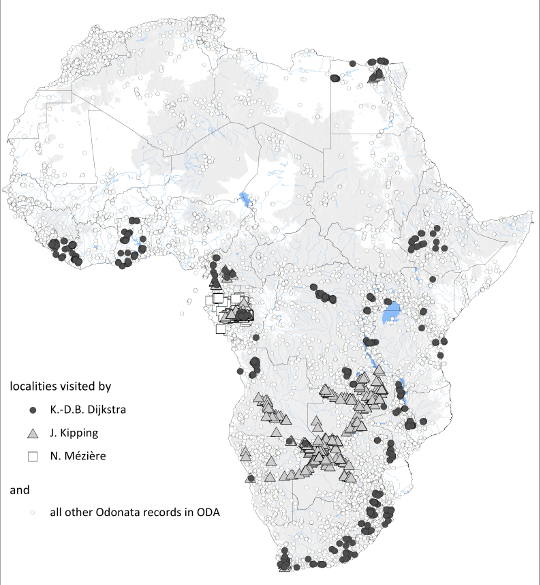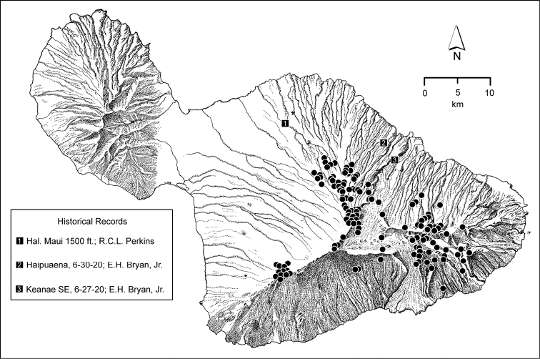This article was published in Scientific American’s former blog network and reflects the views of the author, not necessarily those of Scientific American
Haleakala Volcano on the island of Maui has yielded up 74 new beetle species, while the whole of Africa has contributed 60 new dragonflies, according to two new papers published in Odonatologica and Zookeys this month. Together, the finds are yet more proof that the diversity of life – even large, obvious, often brightly colored life – remains woefully undescribed and unexplored on Earth.
In Africa, three naturalists – K.D. Dijkstra, Jens Kipping, and Nicolas Mézière -- performed old-fashioned natural history: slogging through swamps, fording streams, and scouring lakeshores, butterfly net in hand, for new species of dragonfly and damselfly.

The localities visited by the authors of the paper on 60 new dragonfly species. Map 1 from Dijkstra et al. 2015. Dijkstra is a biologist, Kipping an environmental consultant, and Mézière a high school teacher.
On supporting science journalism
If you're enjoying this article, consider supporting our award-winning journalism by subscribing. By purchasing a subscription you are helping to ensure the future of impactful stories about the discoveries and ideas shaping our world today.
Because this kind of work has fallen out of favor in biology, there are few scientists engaged in it. This crew reflected that. One was a biologist, one a high school teacher, and the third an environmental consultant. Only nine of the 60 new species were discovered by the professional biologist when he worked for a university or museum on "academic" time; 21 more were discovered by the biologist working as a paid consultant, and the rest by the teacher or professional consultant in their spare time. In one stroke they increased the number of known African dragonfly species by 10%.
Finding the news species of dragonflies and damselflies (close dragonfly relatives) was easy – they were clearly distinguishable by sight. A few got names as scintillating as their forms; the Robust Sparklewing was dubbed Umma gumma after a 1969 Pink Floyd album. Others present natural history mysteries that await detective work. Male polychrome jewels, Africocypha varicolor, come in three flavors: those with red, yellow, or blue tail tips. No one knows why, and no other dragon or damselfly has ever been seen to exhibit this coloring system.
If you want to give yourself a small but relaxing present, go to their photo gallery of new species and their habitats and treat yourself to a slide show, advancing slowly, one by one, and savoring both the stunning dragonflies and the photographs of their habitat in a wild Africa that few of us have ever seen. You can see the polychrome jewels with the three paint jobs in the fifth full row up from the bottom. If you would prefer the less aesthetically pleasing but more informative powerpoint presentation, it is here. I recommend starting with the slide show.
On the flanks of Haleakala Volcano on Maui, biologist James Liebherr discovered 74 new species of round-waisted predatory beetles in only about 500 square miles. Although not as easily distinguished as the African dragonflies, they are all obvious and “very abundant”.
.jpg?w=540)
Mecyclothorax medeirosi, a new round-waisted predatory beetle from Maui. Beetle is 4.4 mm long. Fig. 49c from Liebherr 2015.
This brings the total number of round-waisted beetle species to 239 in the Hawaiian Islands. Even more amazingly, all of these species descended from a single colonizing beetle population, an adaptive radiation that puts Darwin’s 13 or so finches to shame. Haleakala is only 1.2 million years old, and there are 116 round-waisted beetle species on it. That evolutionary pace exceeds the rate of speciation of Hawaiian fruit flies in the genus Drosophila and the cichlid fishes of eastern Africa.

Collection sites of round-waisted predatory beetles on Haleakala Volcano, Maui. Fig. 6 from Liebherr 2015.
The finding of 74 new species in only 500 square was also made possible by the unique geography of a volcano, where mud flows, lava flows, or steep-walled valleys create islands of vegetation. The rainy northeast side of the island also produces rainforests, well-known biodiversity hot spots. Within such micropatches, Liebherr found several forested islands of about one square mile where 20 of the new beetle species lived cheek by jowl together.
References
Dijkstra, Klaas-Douwe; Kipping, Jens; and Mézière, Nicolas. "Sixty New Dragonfly and Damselfly Species from Africa (Odonata)." Odonatologica 44(4) 2015: 447-678.
Liebherr, James. "The Mecyclothorax beetles (Coleoptera, Carabidae, Moriomorphini) of Haleakala-, Maui: Keystone of a hyperdiverse Hawaiian radiation." ZooKeys 544 (2015): 1.